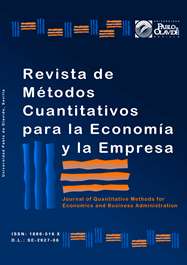Diseño de una carta de control basada en Análisis de Componentes Principales. Un caso de estudio
DOI:
https://doi.org/10.46661/revmetodoscuanteconempresa.3509Palabras clave:
industria química, reducción de datos, análisis estadistico, control de calidad multivariante, variabilidadResumen
El abanico de métodos y técnicas cuantitativas utilizadas para la detección de variaciones de fondo en procesos de manufactura se circunscriben en una disciplina matriz, catalogada como control estadístico de procesos. Tales métodos poseen una aptitud sobresaliente para diagnosticar el estado general de sistemas productivos y realizar una evaluación simultánea de diversas características de calidad interrelacionadas. En el marco de esta investigación, se propone el análisis y monitoreo de un proceso químico sustentado en los principios teóricos del análisis en componentes principales. De este modo, las variables originales seleccionadas son representadas en un espacio dimensional más compacto, bajo la hipótesis de normalidad multivariante. Se construye en la fase posterior, un gráfico de control basado en los cuadrados de los errores de predicción con el objeto de evaluar el comportamiento de los factores subyacentes. Los resultados indican que el proceso no es marginalmente estable y existe un margen de reducción de variabilidad significativo.
Descargas
Citas
Bógalo, J. (2012). Componentes subyacentes comunes en series temporales. Madrid: Universidad Nacional de Educación a Distancia. Recuperado de http://e-spacio.uned.es/fez/eserv/bibliuned:masterMatavanz-Jvbogalo/Documento.pdf
Camacho, J., & Ferrer, A. (2014). Cross-validation in PCA models with the element-wise k-fold (ekf) algorithm: Practical Aspects. Chemometrics and Intelligent. Laboratory Systems. Valencia: Elseiver.
Camacho, J., Pérez-Villegas, A., García-Teodoro, P., & Maciá-Fernández, G. (2016). PCA-based multivariate statistical network. ScienceDirect, 59, 118-137.
Costa, F., Pedroza, R., Porto, D., Amorim, M., & Lima, K. (2015). Multivariate Control Charts for Simultaneous Quality Monitoring of Isoniazid and Rifampicin in a Pharmaceutical Formulation Using a Portable Near Infrared Spectrometer. Journal of the Brazilian Chemical Society, 26(1), 64-73.
De Ketelaere, B., Hubert, M., & Schmitt, M. (2015). Overview of PCA-Based Statistical Process-Monitoring Methods for Time-Dependent, High-Dimensional Data. Journal of Quality Technology, 47(4), 318-335.
Dias, C., & Krzanowski, W. (2006). Choosing components in the additive main effect and multiplicative interaction (AMMI) models. Scientia Agricola, 63(2), 169-175.
Filho, D., & Sant’Anna, A. (2016). Principal component regression-based control charts for monitoring count data. The International Journal of Advanced Manufacturing Technology, 85, 1565-1574.
Herrera, J., Herrera, G., & Rahmer, B. (2017). Control Estadístico de Procesos para datos Correlados Serialmente. Un Caso de Estudio. International Conference on Industrial Engineering and Operations Management (pp. 891-904). Bogotá.
Jolliffe, I., & Cadima, J. (2016). Principal component analysis: a review and recent. The Royal Society Publishing, 374, 20150202. DOI: 10.1098/rsta.2015.0202.
Lazzarotto, E., Madalena, L., Chaves, A., & Texeira, L. (2016). Principal components in multivariate control charts applied to data instrumentation of dams. Independent Journal of Management & Production, 7(1), 17-37.
Montgomery, D. (2012). Statistical Quality Control (Séptima ed.). Jon Wiley & Sons.
Owen, J.A. (2014). Principal Component Analysis: Data Reduction and Simplification. McNair Scholars Research Journal, 1, 1-12.
Pérez, C. (2004). Técnicas de Análisis Multivariante de Datos. Madrid: Pearson Prentice Hall.
Phaladiganon, P., Bum, S., Chen, V., & Jiang, W. (2013). Principal component analysis-based control charts for multivariate nonnormal distributions. Expert Systems with Applications: An International Journal, 40(8), 3044-3054.
Quaglino, M., & Vitelleschi, M. (2009). Comparación de Métodos para el Tratamiento de Información Faltante en un Análisis de Componentes Principales sobre Datos Biológicos. Revista de la Facultad de Bioquímica y Ciencias Biológicas, 13, 115-124.
Rahim, M. A., Siddiqui, Y., & Elshafei, M. (2014). Integration of Multivariate Statistical Process Control and Engineering Process Control. International Conference on Industrial Engineering and Operations Management (pp. 470-480). Bali.
Severson, K., Molaro, M., & Braatz, R. (2017). Principal Component Analysis of Process Datasets with Missing Values. Processes, 5(3), 38.
Slišković, D., Grbić, R., & Hocenski, Ž. (2012). Multivariate statistical process monitoring. Tehnicki Vjesnik-Technical Gazette, 19(1), 33-41.
Vanhatalo, E., Kulahci, M., & Bergquista, B. (2017). On the structure of dynamic principal component analysis used in statistical process monitoring. Chemometrics and Intelligent Laboratory Systems, 167, 1-11.
Zude, M. (2008). Optical Monitoring of Fresh and Processed Agricultural Crops. New York: CRC Press Taylor & Francis Group.
Publicado
Cómo citar
Número
Sección
Licencia
Derechos de autor 2020 Revista de Métodos Cuantitativos para la Economía y la Empresa

Esta obra está bajo una licencia internacional Creative Commons Atribución-CompartirIgual 4.0.
El envío de un manuscrito a la Revista supone que el trabajo no ha sido publicado anteriormente (excepto en la forma de un abstract o como parte de una tesis), que no está bajo consideración para su publicación en ninguna otra revista o editorial y que, en caso de aceptación, los autores están conforme con la transferencia automática del copyright a la Revista para su publicación y difusión. Los autores retendrán los derechos de autor para usar y compartir su artículo con un uso personal, institucional o con fines docentes; igualmente retiene los derechos de patente, de marca registrada (en caso de que sean aplicables) o derechos morales de autor (incluyendo los datos de investigación).
Los artículos publicados en la Revista están sujetos a la licencia Creative Commons CC-BY-SA de tipo Reconocimiento-CompartirIgual. Se permite el uso comercial de la obra, reconociendo su autoría, y de las posibles obras derivadas, la distribución de las cuales se debe hacer con una licencia igual a la que regula la obra original.
Hasta el volumen 21 se ha estado empleando la versión de licencia CC-BY-SA 3.0 ES y se ha comenzado a usar la versión CC-BY-SA 4.0 desde el volumen 22.










